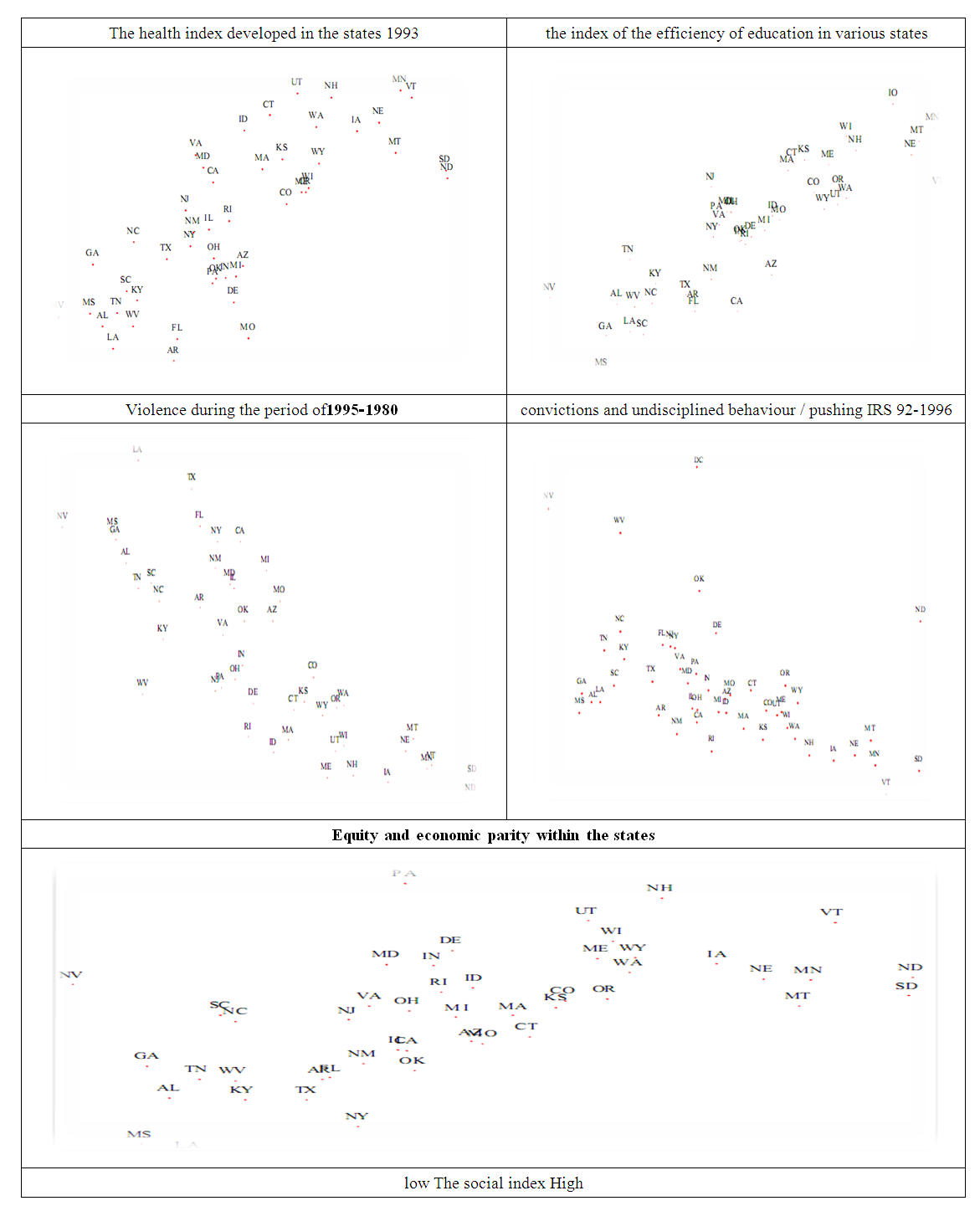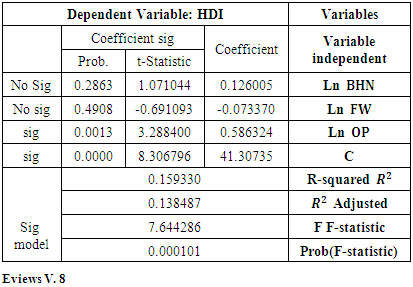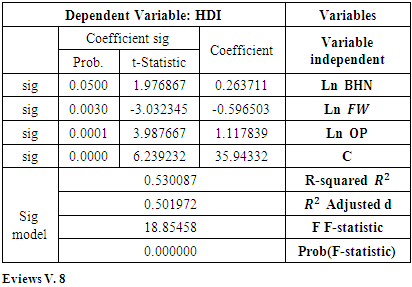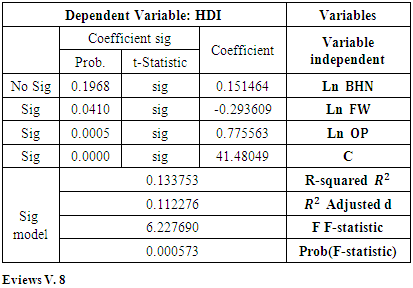-
Paper Information
- Next Paper
- Previous Paper
- Paper Submission
-
Journal Information
- About This Journal
- Editorial Board
- Current Issue
- Archive
- Author Guidelines
- Contact Us
International Journal of Inspiration & Resilience Economy
2020; 4(2): 58-65
doi:10.5923/j.ijire.20200402.03

Measuring the Impact of the Community and Participatory Dimension in the Arab Maghreb Countries (1990-2015)
Boudali Bensekrane, Mohamed Amine Boumediene
Saida University, Algeria
Correspondence to: Boudali Bensekrane, Saida University, Algeria.
| Email: |  |
Copyright © 2020 The Author(s). Published by Scientific & Academic Publishing.
This work is licensed under the Creative Commons Attribution International License (CC BY).
http://creativecommons.org/licenses/by/4.0/

The modern concept of development and achieving sustainable welfare is mainly based on multiple factors between quantity and quality, so that it has a broader meaning, which imposes that the objectives of development for economic effectiveness and material wealth must take account of social and environmental concerns (surrounding) within a general framework of government action. OCDE (2001), the sum of societal and participatory variables such as Trust and Bonding; Bridging; Linking, teamwork and cooperation, shared principles and values, information, communication, solidarity and inclusion among others are resources that have economic value and control with a high degree of well-being and the quality of life through the provision of public goods (education, health) and capital industry Human resources, facilitating operations, reducing costs and preparing to launch investment projects, and achieving social and economic justice.
Keywords: Quality of life, Participation, Social Relations, Wellbeing
Cite this paper: Boudali Bensekrane, Mohamed Amine Boumediene, Measuring the Impact of the Community and Participatory Dimension in the Arab Maghreb Countries (1990-2015), International Journal of Inspiration & Resilience Economy, Vol. 4 No. 2, 2020, pp. 58-65. doi: 10.5923/j.ijire.20200402.03.
Article Outline
1. Introduction
- The concept of quality of life is characterized by ambiguity and overlap, Titmam, Smith & Graham (1997), as a result of the diversity and multiplicity of its components and uses, which makes it rich and very important, as it is linked to two important elements, namely well-being and enjoyment Wellbeing on one side and another side linked to other factors are development, progress and Satisfaction of needs material and others, Fayers.P & Machin.D (2007), so it is a broad concept affected by overlapping aspects of the subjective and objective aspects, McCall.S (1980). Related to the health and psychological state and the extent of freedom and independence of activity and decision-making within the framework of his environment, and the intensity of his social relationships, Bonomi.R.E, Patrick.D.L. & Bushnel.D.M (2000).
2. Concepts of Quality of Life
- The quality of life includes enjoyment of material conditions and a sense of well-being, satisfaction of different needs and satisfaction with life, good mental and health condition and a sense of happiness in light of the prevailing values. And the period after the eighties with the end of the millennium and the beginning of the new millennium, and the technological revolution created a revolution in the quality of products from goods and services, diversified, promoted and facilitated, and created standards for them to be adopted and applied in the fields of: culture, medicine and psychology, sociology, environment and economics.The individual's awareness of his living situation in the context of cultural systems and values in the society in which he lives, and the relationship of this awareness with its goals, expectations and level of interest." World Health Organization WHO-QOL Group (1994).A comprehensive concept that includes all aspects of life as individuals perceive it and it expands to include the material satisfaction of the basic needs and the moral satisfaction that achieves the psychological compatibility of the individual through his own achievement. Accordingly, the quality of life has objective conditions and subjective components, and the fundamental element in the word quality is evident through strong emotionalism. Between the individual and his environment, and this relationship, which is mediated by the feelings and feelings of the individual and his perceptions, and stresses the importance of the role of the environment and cultural factors as determinants of the quality of life. Rogreson, 1999 - United Nations to Educationnel and Science and Culture Organization, Diener.E, Suh.E.M, Lucas.R.E & Smith. H.L (1999), and David.G and Myers (2000) see the quality of life as the best presence, through which society and government are monitored and evaluated to achieve a strong level of quality of life" Kahenman & all.1999 important indicators are used to denote the quality of life, Kahenman.D, Deiner.E, and Schwarz.N (2003):• Income level and living condition• Social environment and public health• The subjective feeling of being the best or extent feeling of gratification or not• The prevailing mood is pessimistic optimism• Emotional state, such as happiness and miseryRubin defined it as "the integration and integration of several trends in the individual in terms of physical and psychological health and social life, including both cognitive comportment, which includes satisfaction and emotional components, which include happiness", Rubin.R (2000), and when Reine and others are the individuals' sense of happiness and satisfaction in light of life conditions It is influenced by life events and treatments, changing intensity of emotion and feelings, and the link between assessing objective and subjective quality of life is affected by individual attitudes, Reine.G, Lançon.C, DiTucci.S, Sapin.C (2003).It is a multidimensional concept that includes a range of areas including health, social relations, an active job role, and self-satisfaction with life, Becker.M, Shaw.B, Lisa.R (1997), while it is: “A person’s sense of good condition, contentment, dissatisfaction with life, happiness or sadness”, Ferrans.C & Power.M (1985), and Hajiran believes that the quality of life is affected by several factors, including the characteristics of individuals themselves or their environments or the interaction between them, because the individual's feeling of security in establishing social relations and his freedom, knowledge and health, in addition to the economic, spiritual and recreational aspects are important indicators of the quality His Life, Hajiran.H (2006).
3. Dimensions of the Quality of Life
- a. Self-Dimension: Extent of personal satisfaction with life, a person's sense of quality of life, and a person's sense of happiness.b. The objective dimension: physical health, social relationships, community activities, work and life philosophy, free time, standard of living and family relations, mental health and education ... and others.
4. Quality of Life from a Societal, Participatory and Economic Perspective
- In order to capture the concept of social indicator and control it more, it is necessary to refer to societal and participatory variables such as trust and networking (unified bonding, bridging and linking), teamwork and cooperation, common principles and values, information, communication, solidarity and integration, and others are resources that have an economic value that makes them control with high In achieving sustainable economic and human well-being, and improving the quality of life through the provision of public goods (education, health) and the manufacture of human capital, facilitating operations, reducing costs, preparing investment projects, and achieving the social and economic justice, Darlauf.S.N. & Fafchamps.M (2004), are as follows:
4.1. Social Index, Trust and Efficiency of Social Exchange
- Trust is on the one hand, "a source on which the social indicator depends, and on the one hand it is a result of it, which is almost like an alternative value to a number of rules, beliefs and values that support social cooperation, OCDE (2001)," Both public goods and, first, trust in the meaning of "Béhaviorisme", that research and confidence at Fafchamps.M are essential determinants of the effectiveness of social exchange, and when ways are found to facilitate research and encourage mutual trust, we can develop and develop social exchange, there are three categories:Trust between knowledgeable people (family, colleagues, and neighbours).Trust between foreign people (who are not familiar with each other).And Confidence in public and private institutions.
4.2. Research and Social Networks; Bonding, Bridging and Linking
- Its role lies in research and transfer of resources and competencies and experiences, they are channels of convergence and integration of types of capital, illustrated by research costs in relation to suppliers and customers, production and market services from storage and transportation, expanded fairness learned and work, and the state of work in the markets where there is no current and equitable equivalence of current information about available occupations and jobs And labor - workers.
4.3. The Social Index and Public Goods
- Public goods are an essential feature of the social indicator, for example education, health, services provided, etc., all of which belonged to the members of the group, the role of trust in accelerating exchange and its efficacy, and trust is an essential ingredient in the liberalization and collection of public goods, an example as confirmed, Coleman.J.S (1988), we say work The collective collaborator stands out as a permanent and strong alternative to the responsible body, and there are two required ingredients:Trust confidenceResponsibility leadership
4.4. Social and Equity Index
- The idea of equity in the field of human development focuses on equality for all in civil society and its diverse groups in order to obtain education, health, civil and political rights. It includes a share of efficiency and achieving wide efficacy without distant exclusion, benefit from the returns and results achieved, and "the results are bad, undesirable, and unfair when", Putnam.R (1995):The benefits accrued to dedicated members are provided for them only. And Membership in the network is not instant, but gradual.
4.5. Social Indicator and Networks (Social Participation and Contribution)
- Studies of the social index and in the work of Putnam.R, Leonardi.R And Nonetti.R.Y (1993), in northern Italy, there was a noticeable development rapidly compared to the south, due to the difference in the level of performance to a higher degree in the north than the other, and this reference shed light on the effects of the social indicator and its many positives, then R. Putnam in his recent study of the United States (1995, 2000) laid the true correct foundation, focusing on the course of the development of social behaviour in the United States since 1950.
5. Theoretical Approaches to Quality of Life
- Theoretical approaches vary between the social trend, Bigelow.D, Mcfarland.B, Olson.M (1991), the psychological and philosophical trend, Tiliouine.H, Cummins. R.A and Davern.M (2009), the medical and health trend, Lisa G. Aspinwall, Ursula M. Staudinger (2003), and other theoretical trends as follows, Raphael.D, Renwick.R, Brown.I, Rootman.I (1994):
5.1. Knowledge Orientation
- First, it depends on the nature of perception that affects the feeling of quality, and secondly, the difference in perception depends on the subjective and objective reasons less than it, and believes that the spatial and temporal environment controls a high rate of the degree of feeling the quality of life and its achievement, and the exploitation of opportunities available in specific periods, Hahnemann.D, Diener.E, & Schwarz.N (1999), which is a concept that includes multiple dimensions as planned by under the name of the three B, the 3 B's, namely Being, Belonging, and Becoming, Craig A. Jackson (2010):

5.2. Humanitarian Orientation
- The idea is that the quality of life depends on the existence of the appropriate individual first, and then second, the presence of a suitable and suitable environment and interact with it according to theory, According to the ruler dimensions, Ryff.C, Keyes.C (1995), who emphasized that the quality of life is the ability of the individual and his ability to cope with the crises that appear in its various successive stages, which in turn affects the feeling of happiness and contentment with the results: independence and freedom of decision-making. - Appropriate environment and empowerment. - Personal growth, Positive social relationships, Confidence and self-acceptance, and the goals for life.
5.3. Integrative Orientation
- The concept adopted from the concepts of happiness, the meaning of life, the biological information system, real life, and the fulfilment of needs, as well as other objective factors, an integrative theoretical framework, Anderson.T (2003), and indicators related to the quality of life are: - feeling satisfied. Set realistic goals with the ability to achieve them. - Change the reality in line with the goals. Satisfying life does not necessarily lead to contentment and a feeling of quality of life.
6. Effects of the Social Progress and Participation Index on Achieving Quality of Life and Wellbeing
- Theoretical and applied studies on the impact of the social indicator and its role, and the objectives expected to be achieved by implementing policies and programs, have generally come with "nine major" headings, Woolcock.M & Narayan.D (1999) which have work throughout them and they are all factors involved in the strategy to achieve quality of life and social and economic well-being in general and overall, Levesque.M & White.D (1999), we take an example of that with regard to education, health, safety, criminality, justice, cultural work, sports, various activities and volunteer work, transportation and housing, Graczy.J.k (2002), among others:Families and problems with young peopleEducation and achievement level.Social connectedness, civil societyVarious social organizations and their role.Governments, transparencyCivil participation freedomsPublic Situation and the challenge in DiversitySocial welfare and public healthCorruption and crime controlEconomic development
6.1. Impact on Education and Civil Society Culture
- One of the bets on education is: reducing unemployment, achieving welfare of the student, ability to integrate quickly and portability, upgrade network density and promote social development, accumulate human capital and develop the level of competencies, "on the one hand we find exchange, trust, the ability of the other and cooperation with him, and on the other hand for him Contribution to reducing problems and criminality, and combating (exclusion and marginalization) poverty."It confirms Bourdieu's, Bourdieu.P (1980), analysis, which linked it to cultural capital and demonstrated the role of knowledge and knowledge aspiration, both in terms of communications and in terms of experience and acquired competencies, as well as J.Coleman in his research on the social index and industry the capital Human.
 | Figure 1. R. Putnam measured the impact of participation and social progress on achieving quality of life and well-being |
|
6.2. Impact on Health
- It is one of the indicators of the level of social and welfare we have, and it is one of the types of public goods, consumed by people to develop their physical capabilities, take care of their personal characteristics and improve the standard of living, which is part of the composition and accumulation of human capital, and in general health is an important factor for well-being and economic effectiveness: age, lifestyle, Social standing, level of empowerment and competency, solidarity between people, and there are some economists who believes today that health status is part of the human capital variable, OECD (2001).
6.3. Impact on Safety, Cooperation, Discipline and Teamwork
- To be more susceptible and prolonged privacy in a specific meeting and workers in the field of identifying Anatolia, the few and the nervous, through joint teamwork between us and the contestants and volunteers who participate in the circle of trust and exchange, OCDE (2001), and decides to link proportionally between the level of criminality, social trust and inequality, kawachi & Kennedy (1997), shared Leading of Carcach.C and Huntley.C (2002), " when the crime rate decreases in the face of social participation, especially that the decrease in violence seems more directly related to the informal supervision practiced by the residents and their social cohesion.
6.4. Achieve Economic Success and Luxury
- Economic success depends on the social environment, the first criteria, ratios for raising the level of standards, the presence of job offers according to the privileges granted, the presence of collaborative and organized collective work, social promotion and expansion of the field of trust and social exchange, its factors on the individual and the group, and its impact on human capital, public goods, and contribution (synergy), Decline in social capital in the USA in incomes and wealth.
7. Data Analysis
- A standard study of the impact of the societal and participatory dimension in achieving the welfare of life in the Arab Maghreb countries through the PANEL model:In this part of the applied study, we relied on PANEL data models in order to estimate the human welfare function during the period (1990-2015) for the Arab Maghreb countries.
7.1. The Human Welfare Function in the West Arab Countries
 So that: 〖(HDI)〗 _ it: represents the quality of life variable expressed in the Human Welfare Index for each country (i) From the Arab Maghreb countries with t = 1990 to 2015〖(BHN)〗 _ it: represents the variable of Basic Human Needs for public goods, expressed in the nutrition and medical care index for each country (i). From the Arab Maghreb countries With t = 1990 to 2015〖(FW)〗 _ it: represents the variable of development elements expressed in the indicator of access to Information And Communications for each country (i). From the Arab Maghreb countries with t = 1990 to 2015〖(OP) it _ it: expresses the Opportunities, Porter.M.E And Stern.SC and Green.M (2014), And Participation, Biondi.M, Chairman.B (2015), for each country (i). From the Arab Maghreb countries With t = 1990 to 2015
So that: 〖(HDI)〗 _ it: represents the quality of life variable expressed in the Human Welfare Index for each country (i) From the Arab Maghreb countries with t = 1990 to 2015〖(BHN)〗 _ it: represents the variable of Basic Human Needs for public goods, expressed in the nutrition and medical care index for each country (i). From the Arab Maghreb countries With t = 1990 to 2015〖(FW)〗 _ it: represents the variable of development elements expressed in the indicator of access to Information And Communications for each country (i). From the Arab Maghreb countries with t = 1990 to 2015〖(OP) it _ it: expresses the Opportunities, Porter.M.E And Stern.SC and Green.M (2014), And Participation, Biondi.M, Chairman.B (2015), for each country (i). From the Arab Maghreb countries With t = 1990 to 20157.2. Estimate the Human Welfare Function through the Three Panel Models
7.2.1. Pooled Regression Model
|
7.2.2. Fixed Effects Model
|
7.2.3. Random Effects Model
- It is clear in the results below (Table 3) that the variable effects regression model is significant, and that the value of the weak determination factor (0.133753) indicates that these explanatory variables used in the model explain only 13.37% of the change in the level of human well-being, as for the coefficients of the explanatory variables, they were all significant, except for the coefficient of the necessary human needs variable, which was not significant.
|
7.3. Choosing the Appropriate Form for the Study
- After studying the results of estimating the regression equations through the three Panel models, it is necessary to perform statistical tests in order to determine the appropriate model for the study as follows:
7.3.1. Choose between Two Panel Models: The Fixed Effects Model and the Random Effects Model
|
7.3.2. Choosing between Two Panel Models: The Fixed Effects Model and the Regression Model
- As a second stage, we will choose between the two models of fixed effects and the group regression model using Dammy variables to confirm the hypothesis that there is heterogeneity between countries.
|
7.4. Estimate the Final Form of the Study
- Starting from the final panel model chosen for the study, which is represented by the model of fixed effects, the estimation equation for the total labour demand function is as follows:HDI = 35.9433166636 + 0.263711028609 * BHN - 0.596503064522 * FW + 1.11783894955 * OPThe results of the regression equation indicate the following:* The presence of a positive impact of the variable of necessary human needs, as the value of his coefficient reached (0.2637), which indicates that an increase of 1% in the index of necessary human needs will lead to an increase of 0.2637% in the quality of life expressed in the human welfare index in the Arab Maghreb countries.* The presence of a negative impact of the variable of the elements of development, where the value of his coefficient (- 0.5965), which indicates that the increase of 1% in the index of development factors will lead to a decrease of 0.5965% in the size of human well-being, this result reached is contrary to the positive effect The indicator of the fundamentals of development is to improve the quality of life theoretically, and this confirms that the countries of the Maghreb do not exploit their development potentials and capabilities to improve the level of human welfare.* With regard to the variable of available opportunities, whose parameter reached (1.1178), it indicates that it has a positive impact on the level of human welfare, that is, the increase of 1% in the available opportunities index will lead to an increase of 1.1178% in the level of human welfare in the Arab Maghreb countries.
8. Conclusions
- Just as standard studies on the search for the best available means to achieve comprehensive development with its material and non-material dimensions have proven, we have confirmed that the sum of societal and participatory variables, such as trust and the network of relationships and the resources they carry, such as teamwork and cooperation, common principles and values, information, communication, solidarity and inclusion, and others are resources for them. Economic value, controls Well-being, and promotes The Quality Of Life by providing public goods, formulating human capital, integrating types of capital for investment, facilitating operations, reducing costs, and achieving social justice and Economic, individuals in different countries societies such as the case of the Maghreb, where development shows that the ingredients are available but to no avail to them, as a result of the low level of management and follow-up to the rest of the indicators of quality, relevant access to the well-being and quality of life.
 Abstract
Abstract Reference
Reference Full-Text PDF
Full-Text PDF Full-text HTML
Full-text HTML




